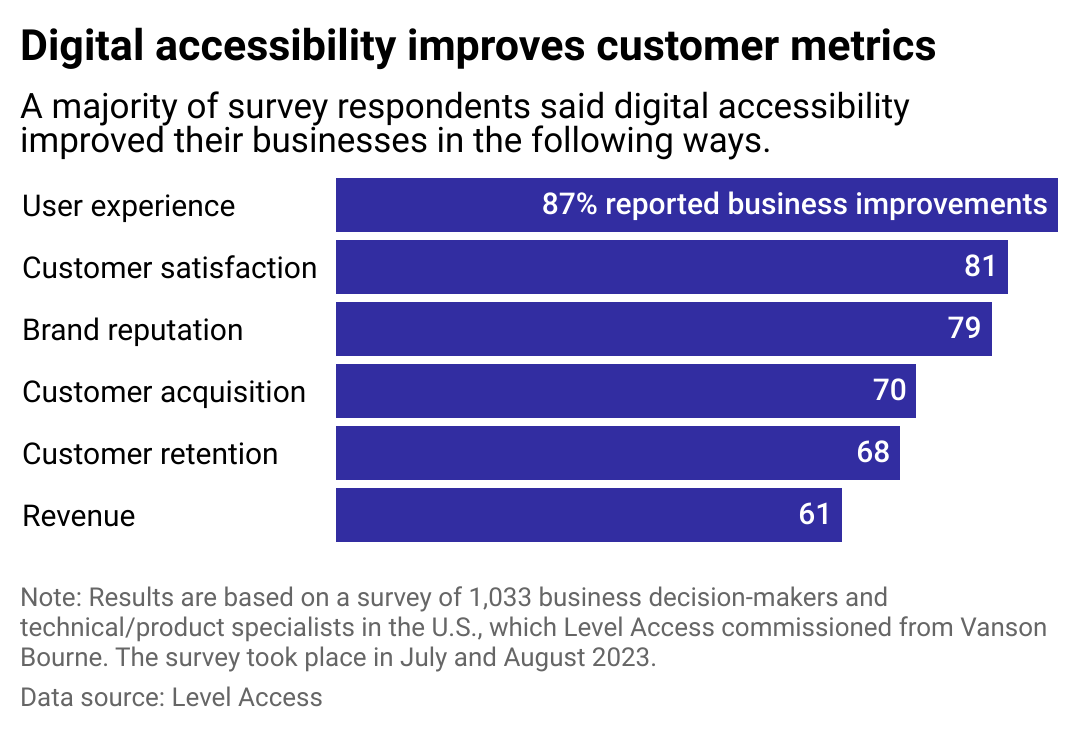
As lawmakers raise the bar for accessibility standards online, Americans with disabilities aren't the only ones who will benefit. Digital accessibility also benefits businesses, boosting revenues and customer satisfaction.
That's according to a 2023 survey of 1,000 decision-makers and technical/product specialists from U.S. businesses. Respondents widely reported that implementing digital accessibility improved their companies' performance in major ways—including the bottom line.
Using results from this survey, accessiBe identified the areas where most businesses reported improved performance due to digital accessibility efforts.
Digital or web accessibility, used interchangeably here, refers to creating websites and applications without barriers preventing users with disabilities from using them. Web accessibility guidelines have existed for decades, including alternative text for images, closed captioning on videos/audio, and the ability to navigate a site entirely with a keyboard.
The Americans with Disabilities Act, which protects people with disabilities from discrimination, became a federal law in 1990. Today, that law is widely applied by many U.S. courts to the digital realm. In 2018, the Department of Justice confirmed the ADA's application to websites, referencing the Web Content Accessibility Guidelines as the standards by which websites should conform under the law. Since then, and as recently as April 2024, the DOJ has repeatedly reiterated this fact.
While some have heeded the call for equality and have taken the necessary steps to ensure their websites conform to WCAG, many more have yet to do so. Close to 96% of all the world's websites have WCAG failures, according to WebAIM, which is part of the Institute for Disability Research, Policy and Practice at Utah State University. With the ADA being a federal law, failing to comply with it can result in fines and potential legal action.
In 2023, the number of web accessibility lawsuits grew dramatically, according to UsableNet's 2023 Midyear Report on Digital Accessibility Lawsuits.
Accessible websites and apps have the opportunity to open businesses to an entirely new clientele while meaningfully shrinking the digital divide. Keep reading to see how digital accessibility has proven good for business.

About 85% of survey respondents called digital accessibility a competitive advantage. A majority also said that implementing digital accessibility directly improved several performance measures, mostly in the realm of customer experience. According to the results, 87% said digital accessibility improved user experience for their business, and 79% said brand reputation improved. Customer retention, which results in steady and increased profits, improved for survey respondents by 68%.
While accessibility in any area is critical for those with disabilities, it typically also improves experiences for people without disabilities. Offering closed captioning on videos, for example, can increase comprehension, memory, and language skills for everyone who watches. Subtitle use is rising even among those who aren't deaf or hard of hearing, offering just one of many instances where accessibility benefits a wide, general audience.
Fundamentally, acquiring and retaining customers is the basis for maintaining and increasing revenues. Company leaders said their accessibility measures boosted their reputations among potential customers, business partners, and future employees. About 3 in 5 survey respondents said their company requires accessibility in the software and digital products they purchase, meaning digital accessibility is important for securing those customers and revenue.
Accessibility also unlocks a market segment left behind amid rapid technological advancements. In 2021, just 62% of U.S. adults with disabilities had a laptop or desktop computer, and 72% had a smartphone, according to a Pew Research Center survey. Ownership of each of these technologies among Americans with disabilities trailed over 15 percentage points behind that of those without disabilities. What's more, 15% of Americans with disabilities say they never go online, and just 75% go online daily compared to 87% of Americans without a disability.
Prioritizing accessibility paves an essential road for the millions of Americans living with a disability, lowering barriers for people to enter the digital world. With heightened expectations for more universal access and better standards, everyone can reap the benefits.
Story editing by Nicole Caldwell. Copy editing by Kristen Wegrzyn. Photo selection by Lacy Kerrick.
This story originally appeared on accessiBe and was produced and distributed in partnership with Stacker Studio.